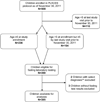Association of Dyslipidemia and Glucose Abnormalities With Antiretroviral Treatment in a Cohort of HIV-Infected Latin American Children
- PMID: 27570910
- PMCID: PMC5140693
- DOI: 10.1097/QAI.0000000000001163
Association of Dyslipidemia and Glucose Abnormalities With Antiretroviral Treatment in a Cohort of HIV-Infected Latin American Children
Abstract
Objective: To estimate the incidence of lipid and glucose abnormalities and assess their association with exposure to antiretroviral (ARV) regimens among perinatally HIV-infected Latin American children.
Design: Longitudinal cohort study.
Methods: Data were analyzed from the Eunice Kennedy Shriver National Institute of Child Health and Human Development International Site Development Initiative Pediatric Latin American Countries Epidemiologic Study. The incidence of dyslipidemia [total cholesterol >200 mg/dL, HDL < 35 mg/dL, LDL ≥ 130 mg/dL, triglycerides > 110 mg/dL (age < 10 years) or >150 mg/dL (≥10 years)] and fasting glucose abnormalities [homeostasis model assessment of insulin resistance >2.5 (Tanner stage 1) or >4.0 (Tanner stage > 1); impaired glucose: 110 to <126 mg/dL; diabetes: ≥126 mg/dL] was estimated. Proportional hazards regression was used to evaluate the risk of abnormalities associated with ARV regimen, adjusted for covariates.
Results: There were 385 children eligible for analysis (mean age 6.6 years). Incident cholesterol abnormalities were reported in 18.1% of participants [95% confidence interval (CI): 14.1% to 22.8%], HDL and LDL cholesterol abnormalities in 19.6% (15.1%-24.7%) and 15.0% (11.3%-19.5%), respectively, and triglyceride abnormalities in 44.2% (37.7%-50.8%). In multivariable analysis, ARV regimen was only associated with triglyceride abnormalities; participants receiving a protease inhibitor (PI)-containing regimen were 3.6 times as likely to experience a triglyceride abnormality as those receiving no ARVs (95% CI: 1.3 to 10.5; P = 0.0167). The cumulative incidence of insulin resistance was 3.8% (1.8%-7.1%); there were no incident cases of diabetes and only 2 of impaired fasting glucose.
Conclusions: Children receiving PI-containing regimens were at increased risk of developing triglyceride abnormalities. Continued monitoring of lipid levels in children receiving PI-containing regimens appears warranted.
Conflict of interest statement
The authors have no other funding or conflicts of interest to declare.
Figures
References
Publication types
MeSH terms
Substances
Grants and funding
LinkOut - more resources
Full Text Sources
Other Literature Sources
Medical
Research Materials
Miscellaneous


